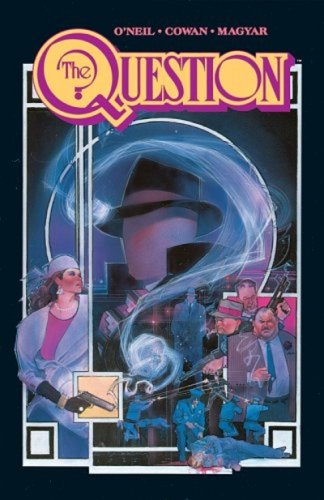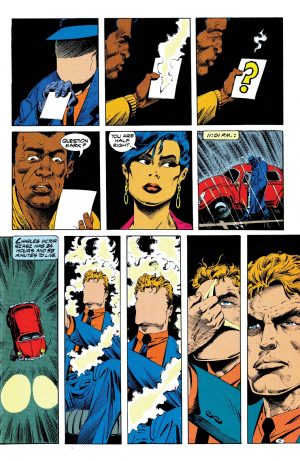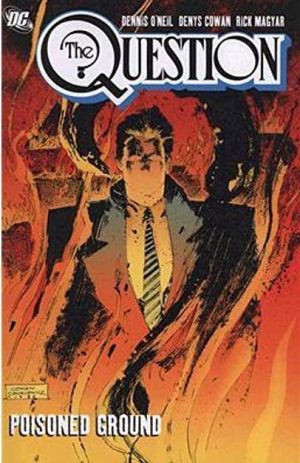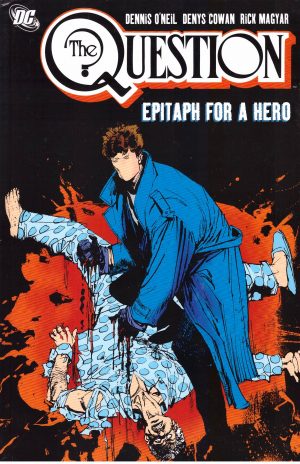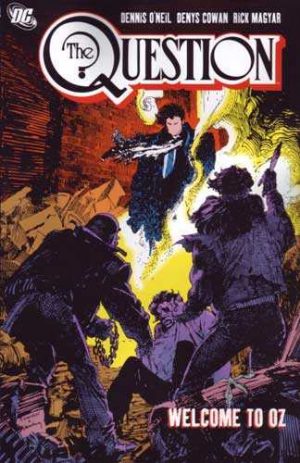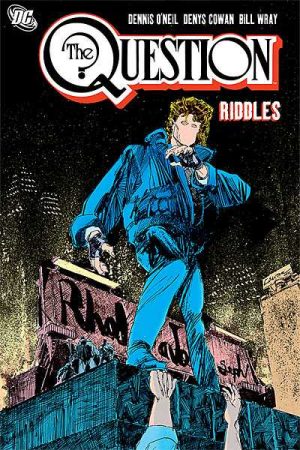Review by Frank Plowright
As created by Steve Ditko in the 1960s, the Question was very much out of step with the times, yet that early incarnation of provocative Libertarian TV news presenter Vic Sage would be very recognisable today. However, he wasn’t just an opinionated mouth, he took action and fought crime as the Question. Zen and Violence introduces Liberal writer Dennis O’Neil’s 1980s update. It’s a long and strange journey over six volumes, of which this is the weakest, but it’s still very readable.
The weakness is partly down to O’Neil not necessarily sure he’d have a long run to explore his ideas, so he sticks relatively closely to the crime thriller template. The Question’s unique selling point is a mask he wears hiding his features and so giving the impression of a man without a face, and Denys Cowan’s art shows how creepy the effect is. However, equally important is his uncompromising day job fighting corruption in Hub City over the airwaves. That’s just updating Ditko’s version, but even at this early stage O’Neil adds to the picture, introducing the idea of Sage having philosophical discussions with the provider of his equipment, and explicitly showing the effects of violence on an urban vigilante. Bruises and injuries sustained during Sage’s masked activities are shown when he returns to being a civilian.
Once he’s introduced the confident and capable Sage/Question O’Neil ends the first chapter with what’s still a good surprise despite having been mentioned early. As a whole the series is a journey, and the first chapter ending is really the beginning. That’s the sort of Zen advice occasionally supplied, and O’Neil also ships in a couple of long forgotten characters from his 1970s Kung-Fu Fighter series, adding a less commonplace reading of what the Question could become. There’s definite transition regarding that, a period of questioning who the Question is if you will, and that journey occupies the entire book.
At this early stage in his career Cowan was an artist with phenomenal promise still searching for a style. Exceptional pages mix with the ordinary, but panel to panel continuity isn’t always as clear as it ought to be, and a couple of times what are meant to be climactic points are plain poorly composed. However, when Cowan hits form the pages are a treat.
Because O’Neil attempted to root The Question in the 1980s he was styled to be modern rather than timeless, which means some aspects have inevitably dated, the fashions and hairstyles obviously, but also the way O’Neil attempts to make his thugs distinctive instead of generic. However, one of them eventually stands out, corrupt police officer Izzy O’Toole, who’ll take his own journey.
Unusually, time passes in The Question. The events of the first five chapters occur over a year, and time will continue to pass. As abruptly and luridly as it ends, the final chapter is more representative of what’s to come. It’s a complicated psychological drama about identity and father issues with some social relevance thrown in. Find more of the like in Poisoned Ground, or find both plus most of the following three volumes in hardcover as The Question Omnibus.
